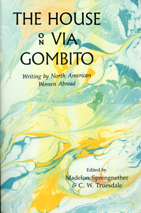The small plane from Houston banked lower, the clouds parted, and there lay a wide, dry plateau spread with cactus like huge Gumbies ready to jig. The word arroyo came back to me: deep fissures in the earth, which would turn into torrents in sudden rains. But the rainy season had passed, said Daniel, our van driver from Leon. Daniel, with dual citizenship, had just finished his stint in the U.S. Marines. Which was worse? one of us asked, Afganistan or Iraq?
Iraq, he answered. There the enemy hid behind buildings. In Afganistan you could see them coming acriss the high desert. Just like here, I thought, and remembered Mary Morris’ foray into the desert beyond San Miguel. Dangerous, she wrote in her book Nothing to Declare. Dangerous especially for a gringa, yet the landscape called, and jumping a sewage ditch, she climbed higher. A green hummingbird delighted her, and there at the mouth of a cave she spied a woman in white watching her. Perhaps a bujo, witch; perhaps her guardian spirit.
I came to San Miguel de Allende to teach a memoir class in the home of a friend. Thus my first significant impression was that home which one entered like a white labyrinth, winding back and back until the dust and noise of the street disappeared before a small green oasis of jade plants. On Pat’s third floor terrace, we sat and drank wine, and I fell in love with the high sky full of puffy white clouds. A small bird landed in a nearby mesquit tree: brilliant red with black wings. Vermillion flycatcher, said the Aves (Birds) of Mexico book.
San Miguel is a city, not a town. A city of many faceless houses along narrow cobbled streets. Walking can be treacherous. The City of Fallen Women, I learned, and vowed not to fall. But the third day I got sick with some intestinal bug. I was the teacher stretched out on the sofa under the turquoise wool blanket. The concrete, modern house with its many small balconies and roof-top terrace was chilly. That night I asked Pat for an electric blanket and sank into the pleasure of chill-warming heat.
The Jardin (pronounded “hardeen”) is the center of civic promenade. Like every other public park I saw, the Jardin (garden in English) is composed of rows of benches set under laurel trees pruned to look like boxes. It’s a very odd sensation: box after box of green facing a church like a pink drip castle. Pat’s grand-daughter, meeting this Parrochia, asked, “Does Cinderella live there?” She has a point.
We had come to take part in Day of the Dead, which began on our Norde Americano Halloween, with kids and parents threading through the Jardin with open tins or sacks. Many little girls were dressed in fluffy, elaborate outfits, yet their faces were skulls–Cristinas, I believe they are called. Death decked out in her finery! Very odd, indeed, embodied in children. Why am I not spooked by U.S. kids with skull masks, yet these girls troubled me? I think it was the combination of sexy beauty on a child, plus the skull face. Very creepy, but the kids seemed fine, if a little solemn.
Before we left, Pat and I visited the very old cemetery, recently cleaned of ancient filth, and the old tombs, odd-shaped, above-ground bulbous shapes, painted pale pink, grey, yellow, blue. To honor the dead, there were only marigolds–the traditional flower. Orange petal blankets around the tombs, bouquets of orange marigolds, marigold blossoms tucked in crevasses and climbing up trees. The brilliant simplicity took my breath away. Its beauty was both strange and commanding; Stop here, notice and honor, the flowers seemed to say, and we did.


Anonymous
Margot, I must hear more about your trip to Kaui. We want to go there! My mother’s peaceful passage has given us new freedom. You have a great way of bringing everything back to the state of our planet. I totally agree about plastic.
Barb P